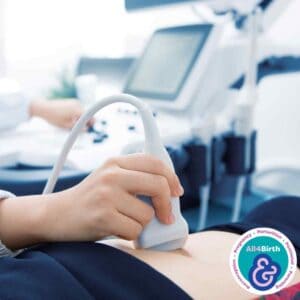Optimising Physiological Birth On A Labour Ward
Angie Willis
Fetal Surveillance Midwife
MSc Professional development, PGdip public health nursing, BSc Midwifery
Instagram @theecomidwife
Summary
Labour ward environments can be the safest choice for some women. Many women choose to birth in a labour ward either because of additional monitoring recommended by their midwives and obstetricians based on previous medical conditions, current pregnancy conditions, requesting an epidural in labour, induction of labour or if women have symptoms such as premature labour, meconium (baby poo in the waters) or bleeding where additional monitoring and support is recommended.1 Whilst home birth and birth centre births have higher spontaneous vaginal birth rates than labour wards, there are many ways you can increase the chances of a physiological birth on a labour ward.
Environment
So you walk into the room in a labour ward and you immediately see the bed as the focal point, with the bright lights above. Instantly your mind screams we are in a hospital, this doesn’t feel safe or comforting to birth in. BUT you can change this make the room whatever you would like. You can ask if your unit has beanbags, birthing balls, floor mats. Raise the bed in the air to lean on and stand upright, or support yourself in an upright forward and open position on a birthing ball. Ask if you are able to use the pool room if there is one available, or have a bath in the bathroom.
Turn off the main lights and close the blinds. The examination light is a great light for the room if there is one available. Turn the examination light on and turn it round. It provides enough light for the midwife or doctors to see, but it makes the labour room feel safer, warmer and more inviting. A set of sunglasses or an eye mask are also other options too, and usually really useful if your hospital have triage waiting areas before you have the first assessment in labour.
Consider taking some battery operated fairy lights or LED candles in too. This is a great way of making the birthing room appear less clinical, again more cosy and homely and a really easy way of boosting your oxytocin levels, helping you to relax.
Take music with you to either use on headphones or take a speaker in with you to play music throughout the room. Music has been shown to lower the amount of pharmaceutical pain relief women need in labour; it helps to promote relaxation and is a welcome distraction technique. Put together your playlist during pregnancy.3
Take in your own pillow or items which smell of home. Pillows in the NHS are like gold dust and seem to get eaten as there tends not to be more than 1 per person in a hospital. Taking your own pillow in will give you additional support in labour by smelling of home, can be used to help you adopt side lying positions with support and is great for supporting you after birth both with sleep but also if you choose to breastfeed too. You can always take in a body spray that you like to spray in the labour room, or if you have had a consultation with a trained aromatherapist you can consider taking in an aromatherapy diffuser too – just let your midwife know what you are using as certain aromatherapy oils can’t be used with certain interventions or around women who are less than 37 weeks pregnant.4
Active Birth
Almost all studies into labour conclude women who are upright and active during birth are more likely to have a shorter labour, have a baby get into a better position for labour and birth, women are less likely to have pain relief and less likely to have a caesarean birth, ventouse or forceps birth. Being active and upright also decreases the chance of tearing and episiotomy within childbirth too. You can use the whole room in itself, or move the bed into different positions to help you remain upright, forward and open. If you have an epidural, as soon as it is effective and you can still perform a straight leg raise then ask to turn onto your hands and knees or over onto your side. A peanut ball if available can also help with position of the baby and the progress of labour.5,6,7,8
Monitoring
Are you being recommended to have continuous monitors during labour, and if so ask why. CTG’s (continuous monitors) can be beneficial to provide more information when there are clear risks to mums or babies, but the research shows in women who are low risk of complications, CTG’s can increase the chances of interventions, caesareans, epidural use, ventouse and forcep births. Not all women on a labour ward will be advised to be continuously monitored, but it depends on why you are in the labour ward. If you give consent to be continuously monitored then ask if there are wireless monitors available to help you remain mobile and upright, and wireless monitors are waterproof too which gives you the option of a birthing pool or bath as well to help with comfort. You can be mobile with the wired monitors too, but the leads are only a metre long so whilst you could be sat on a birthing ball, or lean over the bed or be on hands and knees on the floor, you will be slightly more restricted than if you had the wireless monitors.9
Remain hydrated and use the toilet regularly
Remember the uterus is a muscle and requires energy to work and continue those contractions. Isotonic drinks are a great way of keeping your energy levels up and keeping you hydrated. Alternatively I regularly mix packets of sugar in a small amount of hot water, add cold water and squash to keep women energised and hydrated in labour (caution with diabetes here).
What goes in must come out and the toilet is a great position in general for birth, but it will also be a place where you could find privacy for five minutes to yourself as the power of your contractions and labour intensifies. Keeping the bladder empty provides a good amount of space for your baby to move through the pelvis and will encourage your baby to get into better positions with more room available. This is something both your midwife and birth partners can remind you to do every few hours.1,2
Summary
Having a baby in a labour ward can be really empowering and positive for many women. By considering all your options during pregnancy, you can make the decisions which are right for you during labour in a labour ward environment.

Links to resources
 Books
Books
Active Birth – Revised Edition: The New Approach to Giving Birth Naturally – By Janet Balaskas
The Modern Midwife’s Guide To Pregnancy, Birth & Beyond – Marie Louise
 Websites
Websites
Blood to Baby – https://www.bloodtobaby.com/post/new-resource-alert-delayed-cord-clamping-at-caesarean
AIMS Association for improvements in the maternity services – https://www.aims.org.uk/
Dr Sara Wickham – https://www.sarawickham.com/
Birth Place Decisions – https://assets.nhs.uk/prod/documents/NHSE-your-choice-where-to-have-baby-first-baby-sept2018.pdf
References
- Fraser, D., Cooper, D (2009) Myles textbook for midwives. Livingstone Elsevier: London
- Graves, K. (2012) The Hypnobirthing book. Katharine publishing: Marlborough.
- Lin et al (2019) Effect of music interventions on anxiety during labour: A systematic review and meta ananlysis of randomised controlled trials. Peer J 7:e6945
- Tiran, D. Mack, S. (2000) Complementary therapies for pregnancy and childbirth. Bailliere Tindall: London.
- Epidural and position trial collaborative group (2017) Upright versus laying down position in the second stage of labour in nulliparous women with low dose epidural: BUMPES randomised controlled trial. British Medical Journal 359.
- Tussey, C., Botsio, E., Gerkin., R., Kelly, L et al (2015) Reducing length of labour and caesarean surgery rate using a peanut ball for women labouring with an epidural Journal of perinatal education 24(1). Pp. 16-24.
- Michel, S., Rake, A., Treiber, K., Seifert, B, et al (2002) Birthing position on pelvic bony dimensions. AJR 179, October 2002. Pp. 1063-1067. [Accessed 6 January 2002].
- Reitter, A., Daviss, B., Bisits, A., Schollenberger, A, et al (2012) Does pregnancy and/or shifting positions create more room in a woman’s pelvis? American journal of obstetricians and gynaecologists 211(6) Pp.662.
- Fox, D et al. (2021) The use of continuous foetal monitoring technologies that enable mobility in labour for women with complex pregnancies: A survey of Australian and New Zealand hospitals. Midwifery 93 (102887)












